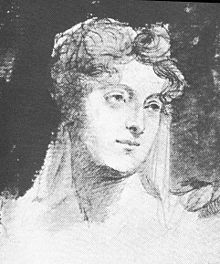Augusta Leigh

Hon. Augusta Byron (born January 26, 1783 at Newstead Abbey in Nottinghamshire , † October 12, 1851 in Little Wilbraham , Cambridgeshire ) was a British aristocrat and the half-sister of the famous poet Lord Byron .
Life
Augusta Byron was the only daughter of the Guard Officer John "Mad Jack" Byron (1756–1791) and his first wife Amelia D'Arcy, 9th Baroness Conyers (1754–1784), on Newstead Abbey, the ancestral home of the Byron family. Her mother died shortly after giving birth and she grew up with her grandmother, Lady Holderness. Her father was considered a bon vivant and was heavily in debt. Fleeing from his creditors, he and his second wife Catherine Gordon of Gight, a Scottish noblewoman and a descendant of the Kings of Scotland , had previously lived in France . Catherine Gordon Byron insisted on giving birth to her son in England and traveled back. John stayed at his sister's house in France. He died in 1791, probably by suicide .
On August 17, 1807 married Augusta Byron in London her cousin (second degree) George Leigh (1782-?), The royal equerry and constant companion of the Prince of Wales and later British King George IV. After the wedding turned out that her Man was addicted to horse racing and had wagered all his fortune. So Augusta was forced to take care of the growing family and got a job as a lady- in- waiting with the Princess of Wales .
In 1805 Augusta Byron met her four years younger half-brother George Gordon Noel Byron, 6th Baron Byron of Rochdale (1788-1824), called Lord Byron, who came from her father's second marriage. They began a lively correspondence that was hardly interrupted until his death. Upon returning from his Grand Tour, Lord Byron became the darling of society, especially women. His affair with the married Lady Caroline Lamb (1785–1828) turned into the season's scandal, and after the relationship ended, rumors of an incestuous relationship with his half-sister Augusta Leigh began. Caroline Lamb herself had at least helped spread the rumor in order to put Byron under pressure and to keep him. After all, Byron had to do something to save his reputation, and above all his sister's. So he stopped on the advice of Lady Melbourne, Caroline Lamb's mother-in-law, to her niece, Lady Anne Isabella Milbanke (1792-1860), who was described as honorable, prudish and God-fearing. However, this initially rejected him and Byron had another affair in public. This time he chose Lady Jane Elizabeth Scott, Countess of Oxford, although he continued to maintain the liaison with Augusta. In April 1814 she gave birth to a child, Elizabeth Medora , who should probably be attributed to Byron. Byron wrote several love poems for his sister: Stanzas for Augusta and Epistle for Augusta ; The motif of sibling love can be found repeatedly in his works: in Cain and Manfred the protagonists love their sisters. Byron continued to apply for Lady Anna Isabella, in which his sister also supported him. Finally with success, and so Byron married in January 1815 and in December his legitimate daughter Augusta Ada was born. Annabella formally separated from her husband in February 1816. The rumors of a love affair with Augusta resurfaced and society turned away from him and cut Augusta as well. Byron found no other way to protect his sister than to leave England forever.
Augusta Leigh died at the age of 68 years from the effects of pneumonia , and her remains were buried in the graveyard of Little Wilbraham in Cambridgeshire.
Trivia
- The first historical mention of the Byron family came from the year 1066, when the Byron brothers accompanied the Norman Duke William the Conqueror to England ( Battle of Hastings ). The family's ancestral home , Newstead Abbey in Nottinghamshire, was founded as a monastery by King Henry II and was given to John Byron, the first lord of that name, by King Henry VIII during the English Reformation ( dissolution of English monasteries ).
- Lady Byron is said to have discovered the love affair between her husband and his half-sister, whereupon she separated from him in horror. In the estate of her aunt, Lady Melbourne, she is said to have found the letters with evidence of an incest connection with Augusta Leigh.
- The novel True story of Lady Byron's life (1869) by Harriet Beecher Stowe is based on the letters that Lady Byron gave to the American writer shortly before her death. The book caused a storm of indignation - against Lord Byron as well as against Harriet Beecher Stowe.
literature
- John S. Chapman: Byron and the Honorable Augusta Leigh , Yale University Press (1975) ISBN 0-300-01876-2
- André Maurois: Don Juan or the life of Lord Byron: a biography , Piper Verlag (1990) ISBN 3-492-11210-2
- Hartmut Müller: Lord Byron , Rowohlt Verlag (1992) ISBN 3-499-50297-6
- Michael and Melissa Bakewell: Augusta Leigh: Byron's Half-Sister: Byron's Half Sister: a Biography , Sinclair-Stevenson Ltd (2000) ISBN 0-18-561975-4
- Tanja Kinkel : Madness that eats up the heart , Goldmann Verlag (2002) ISBN 3-442-09729-0
Web links
- The Hon. Augusta Byron on thepeerage.com , accessed August 16, 2015.
- The Life of Lord Byron (English)
| personal data | |
|---|---|
| SURNAME | Leigh, Augusta |
| ALTERNATIVE NAMES | Byron, Augusta |
| BRIEF DESCRIPTION | British aristocrat and half-sister of the poet Lord Byron |
| DATE OF BIRTH | January 26, 1783 |
| PLACE OF BIRTH | Newstead Abbey , Nottinghamshire |
| DATE OF DEATH | October 12, 1851 |
| Place of death | Little Wilbraham , Cambridgeshire |
